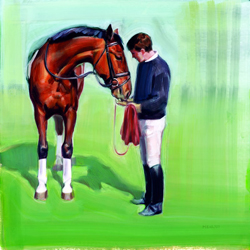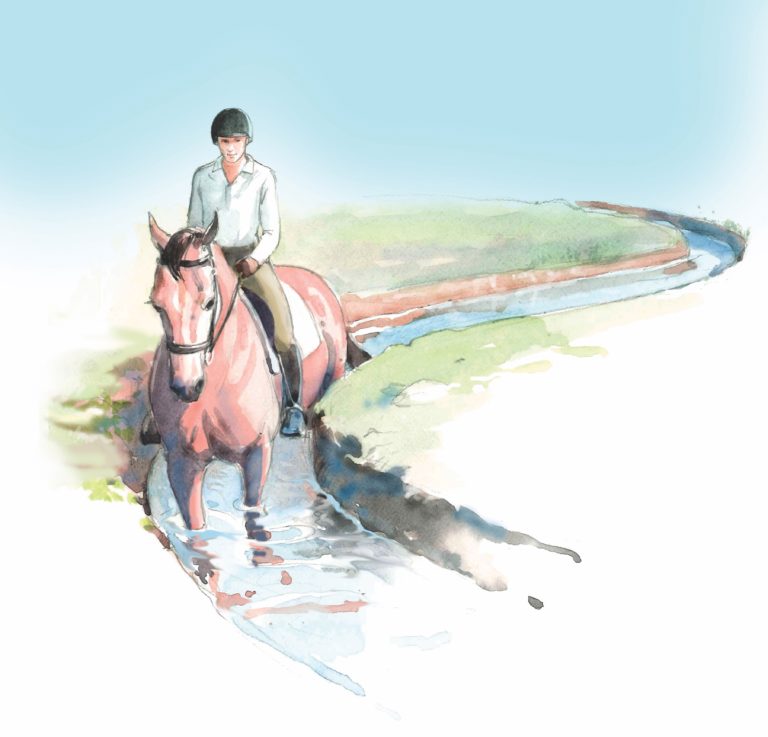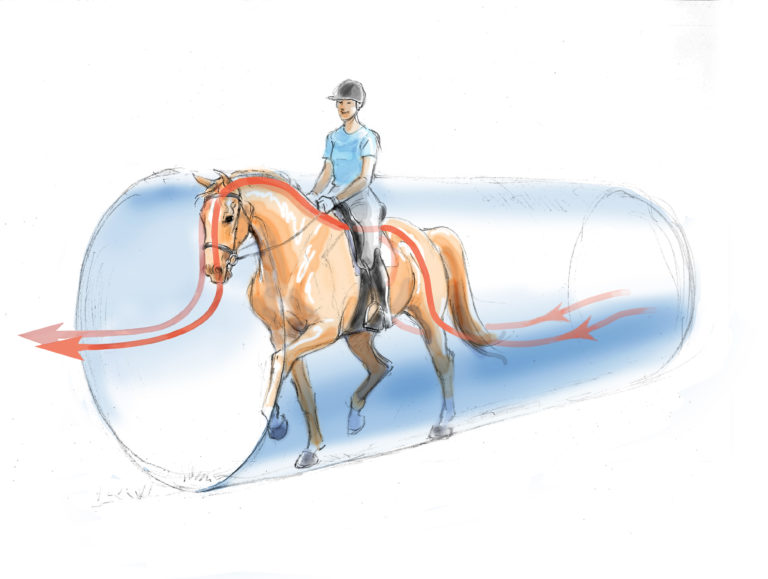
If you have kept up with this four-part series, you will have gained an awareness of the different personality types found among horses and how this understanding helps you recognize or, at times, even predict behaviors (review “The Four Basic Horse Personality Types” in part 1). In addition, in part 3 you read a basic introduction on human personality types, which helps explain why we differ in so many ways from our friends and. Now it is time to talk about how to incorporate this “type awareness” into teaching and training.
Finding the Right Instructor
Clearly an awareness of human personality type can lead to a better understanding about an individual’s behavior, and this leads to better communication, in general. When dressage works and becomes an art form as well as a sport, it is because communication between horse and rider is secure. When a lesson works, it is because teacher and student have communicated successfully with each other about both problems and solutions. Some people, based on their own individual preferences, enjoy lessons that are delivered in an entertaining fashion while others need empathy. Still others value only the information they receive and are businesslike and systematic in their approach to learning our sport. Good instructors need to be aware of the best possible learning environment so that they can help students make the most out of their riding time.
When evaluating a new student who wants to train with the KYB team–my husband Kim, daughter Kassie, our assistants, working students and me–and is serious about getting the most out of her time, I ask the student to take the Myers-Briggs Type Indicator® (MBTI), because it’s important for us to know if someone is an E or an I (extroverted or introverted), an S or an N (sensor or intuitive), a T or an F (thinker or feeler) and a J or a P (judger or perceiver).
Kim is an ISTJ, which means that he is usually quiet, systematic, thoughtful and procedural. I am an ENTJ, which means I am opinionated, very independent, strong-willed and outgoing. I am sure that you can guess how these different personality types affect our individual teaching and communication styles. While we both teach the same subject, our approaches, our wording and even our expectations may differ greatly. So we have found it beneficial to examine both of our teaching styles as well as the learning styles of our individual students. Consequently, our students are divided based on their prior experience, individual needs and goals and whether they have an S (learn best with a factual, literal approach) or an N (learn best from global concepts) preference. Beginning S riders usually starting with Kim. Newer or beginner N riders start with me. We have found this helpful because our different communication patterns have the best chance of matching the individual learning styles of our students.
Later, when each student has developed some basic position and connection skills, we often switch things around so the student can then hear the same information from a slightly different communication perspective.
We have an ESTJ student, Beth, who started with Kim and has stayed with him from Training Level up to the FEI work. Once in a while, I will give Beth a few lessons to help her incorporate a “big picture” approach toward test riding.
Matching Horse & Rider
As professional trainers, Kim and I should be able to handle whatever horse comes our way, no matter our personality type or that of the horse. If you are still developing your seat and communication skills or if you are a less-than-confident rider, then you should look for a horse with fairly passive personality traits. There are exceptions but, generally, a social/aloof or a passive/social/aloof cross would be your best choice. Find a horse that will provide you with the most fun and rewarding experiences as you embark on your own personal dressage journey.
I have an INTJ adult amateur student, Lucinda, who owns and rides a challenging Swedish gelding named Jack. He is about a 5 on the passive/aggressive scale–a talented horse who likes to argue and assert himself. Lucinda gets one or two lessons a week, so she takes the lion’s share of responsibility for Jack’s progress. She prefers things to be harmonious and does not like confrontation herself, but she does understand that she must hold her ground and insist on getting answers to her aids and not get stuck in the arguments Jack so frequently tries to initiate.
Luckily, Lucinda is not overly emotional about her riding and can see that Jack is best handled with a practical approach. Whenever she introduces a new movement or sequence of aids, Jack tries to assert himself by balking, grabbing the bit or pushing against the leg aids. Once in a while, I get on and give clear and, at times, sharp aids to be sure that the message and the responses we expect are clear to him.
When Lucinda sees that Jack can do the work and that she needs to get to the other side of an argument rather than to stay in it, she gains the confidence to push through on her own. If she had gotten stuck in the “Jack trap,” she may have stalled out at Third Level, because that work is easier for the horse and he does not need to apply quite so much of himself to the task. The pair is now working on all of the FEI movements with plans to show Prix St. Georges this year.
Agata, one of our working students, became attached to a mare that, at first glance, would seem an unsuitable match for her. Caroline, an 8-year-old fearful/ challenging cross, is about a 7 on the passive/aggressive scale and has always been a handful. Agata (ENFJ) asked for permission to be part of this mare’s training program. She is a balanced rider and is not fearful herself, but she has never ridden a horse like Caroline–a high energy, complex example of her type. Caroline is the kind of horse who might give the impression that she should be constantly reassured and babied but, because of her additional challenging characteristics, this strategy does not work. Agata has learned to be patient but firm and to ride with clear aids that are consistent from ride to ride. The mare is unpredictable, flighty and at times quite confrontational about the very aids she needs to answer in order to become a reliable dressage horse. Any rider with the Agata’s skills might have trouble or become discouraged in such a situation but, when the mare does comply, she looks beautiful under saddle, and that is all the motivation that Agata needs to continue. Kim and I oversee this project and ride the mare often ourselves to be sure there are no miscommunications about the timing and dosage of aids the mare receives. She is an example of a type that could be frustrating or even dangerous if she were in a different environment, but the only agenda that we have for her is that she continues to make incremental progress.
Another example of the importance of type is my friend and Meyers-Briggs consultant, Gail (ISFJ), who now enjoys an FEI schoolmaster. She wonders why, as an adult amateur with many time and family constraints, she ever tried to go it alone with a relatively untrained horse or one with temperament issues. She is finally able to concentrate on her riding because her passive social/aloof horse is content to behave in a consistent and predictable manner–perfect for Gail’s situation and skill level.
Show Strategies
With all of the possible horse/rider combinations, a good coach and trainer has a full plate at any horse show. When we take our rather large group to a show, our first obligation is to the horses, ensuring their comfort in the show environment and that they still work close to the standards we expect at home.
Some horses need to be reassured and familiarized with everything before they will settle down and work. Some, especially young stallions, get excited and want to socialize or clown around before they are ready to concentrate and focus. It is our job to notice these things and factor them into our warm-up strategy.
The riders are not so different from the horses. Some need to be monitored and reassured constantly because they are insecure themselves. Some need encouragement and pep talks so they don’t start dwelling on the other riders who seem to be having fewer problems. Some just need practical advice about which exercise will best prepare them for the test at hand. We have found that our introverted (I) students who also have an F (feeling) in their four-letter preferences tend to wait until they feel really prepared and confident before venturing into a show situation. In contrast, extroverted (E) T or P students may push to compete before they are ready.
Kim and I have also noted over the years that riders with an S in their four-letter preferences tend to be more practical about the reality of their own individual strengths and weaknesses than their N counter parts.
At the risk of creating a huge outcry, we have observed that N riders may show tendencies to stay too long in an unsuitable horse-rider relationship because they may think that their riding skills will improve faster than they actually will.
As an N rider and advisor, myself, I have been guilty of telling someone we could fix a horse just because I have the necessary skills to do so. Over time though, it has sometimes become evident that even though I could ride the horse successfully and could clearly articulate how to “ride through” problems, I often pushed my riders out of their comfort zones in order to do so. I have learned that it is best for riders to stay within their own natural comfort zones for the majority of their riding experiences. This means that, while we should take advice from the professionals who surround and counsel us, we should remember to listen to our own instincts, as well.
While this series has been a brief introduction to the various human and horse personality types, I hope that these pieces will help you understand a little more about why your horse behaves as he does and why some people handle their riding and personal interactions differently from you. Understanding the strengths we all possess, while learning to handle, ride and train our horses in a way that will most benefit them, is indeed a worthy goal for us all.
Yvonne Barteau is a U.S. Dressage Federation gold medalist. She and her husband, Kim, run KYB Dressage at Indian Hills Training Center in Gilberts, Ill. Her book on horse personalities, Ride the Right Horse, is published by Storey Books and available from HorseBooksEtc.com or by calling 800-952-5813.
This article was originally published in the December 2007 issue of Dressage Today magazine. To order back issues, call 301-977-3900.











